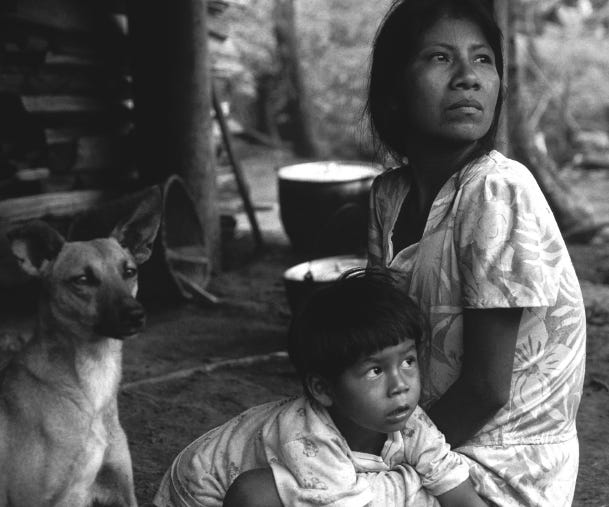Think Like a Jaguar, Speak Like a Tree
Felines and Fungi, the Nature of Mind, and the Wisdom of Forests
Hey, Slick!
Today, I’m bringing you a tale from the forest.
From the jungle, more precisely. A tale of jaguars and trees, mycelium and neural networks, of mind in nature and the nature of mind. A tale of growth, decay, and resilience. Of how forests think, even if not quite like us.
It starts with a lion.
The lion is only a character in our story, an NPC. Lions can’t talk. Wittgenstein (who concerned himself with just this type of theoretical questions) wondered what would happen if they could, and concluded:
If a lion could talk, we could not understand him.
-Ludwig Wittgenstein
The lion’s world is just too different from ours; his concepts and perceptions, and their meaning, too foreign for us to understand him - if he possessed human language.
End of story?
Lion vs Jaguar
Not really. Because Wittgenstein’s lion is no match for Eduardo Kohn’s jaguar. A very real jaguar, and a very real danger to the Runa Puna of the Amazon, who advised the anthropologist before his first night with them in the jungle:
Sleep faceup! If a jaguar comes he’ll see you can look back at him and he won’t bother you.
If you sleep facedown he’ll think you’re aicha [prey, lit. 'meat' in Quichua] and he’ll attack.
-Eduardo Kohn, “How Forests Think”
Somehow, Wittgenstein notwithstanding, I can relate to this jaguar.
Not that I have any instinct to maim or bite anyone who dares sleeping sideways (or worse, on their stomach) - but I can understand that this jaguar has a system, a way of perceiving the world and dividing its inhabitants into I and it, into peer and prey. Eyes looking back mean something different from eyes looking away.
What Eduardo Kohn is saying, in other words, is that if we cannot understand the lion, it’s not a limitation on the lion’s part. Wittgenstein’s famous quote is emblematic of a limiting intellectual stance where, to be understood or valued, the world has to meet us on our terms.
Because we cannot understand the lion or the forest, we don’t see nature as alive with thought and meaning.
It’s not just the jaguar: the whole forest thinks, communicates, perceives, interprets, fleeing at a sound that means a tree is falling, understanding by their colour that one thing is ripe, another poisonous.
Forests don’t speak, but they engage in meaning-making through communication and relationships.
And these are not just the musings of an anthropologist - it’s a whole new understanding of nature, backed by emerging research.
Forest, Fungi, and the Wood Wide Web
Unless you’ve spent the past few years under a stone, you’ve heard of mycelium. The network of fungal threads has weaved its way from the forest floor to books (like Entangled Life by Melvin Sheldrake), documentaries (like Louie Schwartzberg’s Fantastic Fungi) and conversations about nature’s hidden intelligence. Beneath the forest floor, mycelium forms a vast neural network connecting trees and enabling them to communicate, share resources, and coordinate behaviors.
Believe it or not, Slick, this is what actually happens. Mother trees serve as central hubs, distributing nutrients like carbon and nitrogen to younger or weaker trees. This resource-sharing even crosses species boundaries: birch and Douglas fir trees, for instance, exchange carbon seasonally to maintain balance in their ecosystems.
It doesn’t stop there. Mycelium also facilitates defensive strategies: when a tree is attacked by pests, it can signal others nearby through the fungal network, prompting them to activate their defenses before the threat arrives.
These interactions reveal a forest that is far from static—it’s a dynamic, interconnected system constantly communicating and adapting.
Forests think - just not like us. They don’t have centralized brains or spoken language. They don’t have human-style reasoning or cognition. Their intelligence is different - decentralized, relational, systemic - and an emergent property of their interconnected networks.
I believe that mycelium is the neurological network of nature. Interlacing mosaics of mycelium infuse habitats with information-sharing membranes. These membranes are aware, react to change, and collectively have the long-term health of the host environment in mind.
-Paul Stamets
Through mycelial threads and shared resources, forests process information, adapt to challenges, maintain balance. Their ‘thoughts’ are encoded in actions: redistributing nutrients where needed, preparing defences against pests, ensuring the survival of diverse species.
The collective, networked intelligence of forests operates in harmony with the environment - while also in many ways being its own environment, shaping and sustaining the very world it inhabits.
But there’s more, Slick. Different forests think differently.
Forests Old and New
This networked intelligence is not uniform across all forests. Old growth forests and New growth forests think differently. Old growth forests, with their centuries of accumulated complexity, function as stable, reflective minds - repositories of biodiversity, resilience, and ecological memory. New growth forests, on the other hand, are dynamic and experimental, adjusting rapidly to change as they rebuild ecosystems.
Yet, the continuity between them is critical. New growth forests depend on the foundations laid by old growth systems, the reservoirs of life and knowledge stored in their intricate networks (like genetic and microbial diversity).
New growth forests are also those that capture the most carbon, as they turn it into matter. Over time, forests become carbon-neutral: old growth forests do not capture any more carbon, they ’just’ store immense amounts of it.
But their value lies elsewhere: without preserving old growth forests, we disrupt not just an ecosystem, but the very conditions that make renewal and adaptation possible.
Disruption is also a catalyst for renewal, though. It’s chaotic - aren’t we all? - but creates opportunities for innovation and adaptation as new growth forests emerge from the ashes of decay. Disruption prevents stagnation, ensuring the forest remains dynamic and capable of responding to environmental shifts.
Decay, in the right conditions, is also not destruction, but transformation. Fallen trees and decomposed matter are nutrients for the soil, creating the conditions for new life. Maturity leads to decay, decay enables renewal: this cycle ensures continuity, bridging the wisdom of the old growth with the experimentation of new growth.
So, can we learn from the forest? Probably. Ecosystems - and societies - must constantly change and adapt to avoid ossification and maintain resilience. Small, frequent fires prevent rarer, devastating fires. And when those happen, diversity, resilience, collective intelligence can help us rise from the ashes.
Re-thinking the Mind
Groundbreaking, I know. To us, at least; the Runa Puna may not have invented anthropology, but they understood something fundamental about the forest long ago.
And they may not even have been the first ones. This earth-shattering research and theories only confirm what our ancestors knew and practiced - the Runa Puna just never forgot.
Animistic traditions - indegenous and pagan worldviews - saw humans as part of a thinking, interconnected world. Research on mycelium and forest networks validates (’on our own terms’) what animism long intuited: that life operates through collective intelligence and relational meaning.
The Death of Nature didn’t happen overnight. In her book of the same title, Carolyn Merchant argues that the Scientific Revolution replaced the earlier view of the Earth as a living, sentient organism with a mechanistic worldview that saw nature as inert and exploitable.
This shift was a cultural and intellectual revolution, reframing the natural world as a machine to be controlled rather than a partner to be understood. The result wasn’t just a change in how we treated the environment—it redefined what we valued as intelligence and meaning, pushing aside animistic, relational perspectives like those held by the Runa Puna or reflected in the forest’s networked intelligence.
We turned forests into resources and rivers into power. We reduced the intricate web of life to equations and commodities. In losing this connection, Merchant suggests, we didn’t just dominate nature; we lost a part of ourselves—a sense of belonging to something larger, a web of life that sustains us.
Re-think, Renew, Re-enchant
The mechanistic view of nature wasn’t the inevitable product of a rational, enlightened mind: that very same mind, now a little wiser, is proving it wrong more every day.
Yet we are only scratching the surface of what we can learn from billions of years of evolution that have granted nature its awe-inspiring complexity. The human mind is a marvel of evolution; so is the forest mind.
I am not suggesting a regression, Slick. We may have forgotten a lot as we learnt, but learn we did. Our technology is prodigious. The scientific approach allows us to learn from nature like our ancestors did, like when we adapt a peptide from a ‘monster’ to become our fitter, leaner selves (and I’m talking about the Gila monster and GLP-1 drugs, not the movie The Substance) - and more.
But what if they weren’t all wrong? What if we could learn something from the worldviews, values and practices of our ancestors, who lived in better harmony with it?
As humans, we are part of this web of life, not separate from it. Yet, our actions often disrupt the very continuity that sustains us. If we lose the minds of old growth forests, we lose not only reservoirs of life and meaning but the foundations for renewal and innovation.
Forests remind us that resilience isn’t about resisting change - it’s about transforming, adapting, and thriving together. Just like forests, we are shaped by our relationships: the ways we nurture connections, adapt to challenges, and grow stronger through cycles of loss and renewal.
What if we approached our communities, families, or even workplaces like old-growth forests—balancing wisdom with renewal, stability with experimentation? To think like a forest is to embrace diversity, continuity, and the wisdom of life’s cycles, not just in nature, but in how we live every day.
I think it’s worth a try.
And whether you agree or not, Slick, remember this tip from the jaguar: sleep face up.
In the meantime,
Stay Slick
PS: I don’t want to paywall our relationship; I won’t even charge you for the stamps.
You can support my writing here:










Love these observations and thoughts. After reading "The Mountain and the Sea," I bought "How Forests Think." Refreshingly original book and you've captured its message very well and the message's implications. We have a difficulty applying our concepts of mind and thought to the functioning of plants and non-mammalian animals, since every time we use one of those words, it implies something we're familiar with when in fact, we're not. I'm dealing with this in my latest scifi novel, which is in progress, in which the homeostatic and self-preservative behaviors of ecosystems are compared to human conscious actions and the question is asked as to whether it is productive to think of such actions anthropomorphically. You make a good case for why it might be.
Plants, animals and soil, has spoken to me on occasion. Mushrooms, or mycelium if you like, are the most talkative. creatures that you have ancient alliances with, in your family lineage will remind you of this pact, for example. I think it is a matter of being aware of where your consciousness ends, and the others begins. when it is important and they have enough electrolytes and mycelial foundation, they can talk. Especially if they know and trust you.